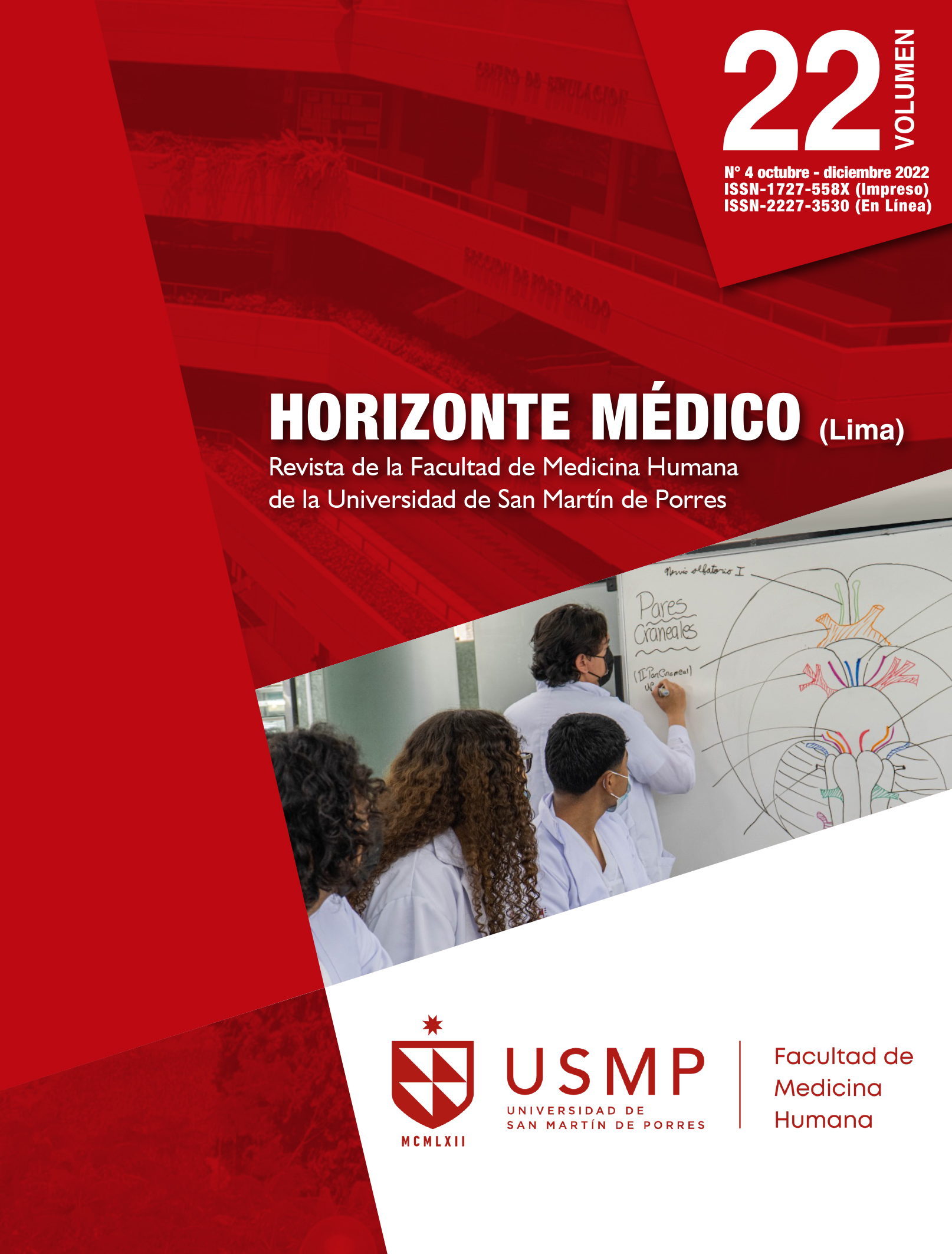Genetic changes in the canonical Wnt/β-catenin signaling pathway in colorectal cancer
DOI:
https://doi.org/10.24265/horizmed.2022.v22n4.14Keywords:
Wnt Signaling Pathway, beta Catenin, Colorectal Neoplasms, Genes, APCAbstract
The goal of this study is to better understand the complexity of the canonical Wnt/β-catenin (C-WNT) signaling pathway in colorectal cancer (CRC): how it works, its key mutations and the novel therapeutic compounds under development. PubMed, Scopus and SciELO were used to find the most relevant medical literature on the issue. The C-WNT signaling pathway regulates essential cellular biological processes: genetic changes in this pathway are significant contributors to CRC. The Wnt ligand binding to the Frizzled receptor and low-density lipoprotein receptor-related protein 5 or 6 (LRP5/6) stimulates the C-WNT signaling pathway; this extracellular membrane ternary complex activates kinases that promote phosphorylation of the intracellular domain of LRP5/6 and starts the cell signaling cascade. The C-WNT signaling pathway is changed in more than 90 % of all CRCs, with the adenomatous polyposis coli gene showing the great majority of mutations in this type of cancer. In recent years, the C-WNT signaling pathway has been an important target for researching new cancer treatments; various inhibitors of the pathway (monoclonal antibodies, inhibitory proteins, selective small compounds and other novel families) have been developed for the treatment of CRC, being the majority of them still in preclinical phases. In conclusion, CRC is related to mutations in the C-WNT signaling pathway, whose persistent activation provides cancer cells with self-renewing growth capabilities and is linked to treatment resistance in CRC. There is active research on novel and innovative compounds that affect this signaling pathway; however, none has received commercial approval so far.
Downloads
References
Siegel RL, Miller KD, Fedewa SA, Ahnen DJ, Meester RGS, Barzi A, et al.
Colorectal cancer statistics, 2017. CA Cancer J Clin. 2017; 67(3):
-93.
American Cancer Society. Cancer Treatment & Survivorship Facts &
Figures 2019-2021. Atlanta: American Cancer Society; 2019.
Instituto Nacional de Estadística e Informática. Registro de Cáncer
de Lima Metropolitana. Incidencia y Mortalidad 2013 – 2015
[Internet]. Lima: INEN; 2021. Disponible en: https://portal.inen.sld.
pe/registro-de-cancer-en-lima-metropolitana/
Novellasdemunt L, Antas P, Li VSW. Targeting Wnt signaling in
colorectal cancer. A review in the theme: Cell signaling: Proteins,
pathways and mechanisms. Am J Physiol Cell Physiol. 2015; 309(8):
C511-21.
Schatoff EM, Leach BI, Dow LE. Wnt signaling and colorectal cancer.
Curr Colorectal Cancer Rep. 2017; 13(2): 101-10.
Hayat R, Manzoor M, Hussain A. Wnt signaling pathway: A
comprehensive review. Cell Biol Int. 2022; 46(6): 863-77.
GBD 2019 Colorectal Cancer Collaborators. Global, regional, and
national burden of colorectal cancer and its risk factors, 1990-2019:
a systematic analysis for the Global Burden of Disease Study 2019.
Lancet Gastroenterol Hepatol. 2022; 7(7): 627-47.
ASCO. Cancer Net. Colorectal Cancer: Statistics [Internet]. 2022.
Disponible en: https://www.cancer.net/cancer-types/colorectalcancer/
statistics
Aldecoa F. Cáncer colorrectal metastásico: supervivencia global con
diferentes alternativas de tratamiento en Lima Metropolitana. Acta
Méd Peru. 2019; 36(3): 195-201.
Vogelstein B, Fearon ER, Hamilton SR, Kern SE, Preisinger AC, Leppert M,
et al. Genetic alterations during colorectal-tumor development. N
Engl J Med. 1988; 319(9): 525-32.
Fearon ER, Vogelstein B. A genetic model for colorectal tumorigenesis.
Cell. 1990; 61(5): 759-67.
Redston M. Carcinogenesis in the GI tract: from morphology to genetics and back again. Mod Pathol. 2001; 14(3): 236-45.
Leggett B, Whitehall V. Role of the serrated pathway in colorectal cancer pathogenesis. Gastroenterology. 2010; 138(6): 2088-100.
Clevers H. Wnt/beta-catenin signaling in development and disease. Cell. 2006; 127(3): 469-80.
Semenov MV, Habas R, Macdonald BT, He X. SnapShot: Noncanonical Wnt signaling pathways. Cell. 2007; 131(7): 1378.
Bejsovec A. Wingless Signaling: A genetic journey from morphogenesis to metastasis. genetics. 2018; 208(4): 1311-36.
Blagodatski A, Klimenko A, Jia L, Katanaev VL. Small molecule Wnt pathway modulators from natural sources: History, state of the art and perspectives. Cells. 2020; 9(3): 589.
Sharma RP. Wingless - a new mutant in Drosophila melanogaster. Drosoph Inf Serv. 1973; 50: 134.
Nusse R, Varmus HE. Many tumors induced by the mouse mammary tumor virus contain a provirus integrated in the same region of the host genome. Cell. 1982; 31(1): 99-109.
Nusse R, Brown A, Papkoff J, Scambler P, Shackleford G, McMahon A, et al. A new nomenclature for int-1 and related genes: the Wnt gene family. Cell. 1991; 64(2): 231.
Kinzler KW, Nilbert MC, Su LK, Vogelstein B, Bryan TM, Levy DB, et al. Identification of FAP locus genes from chromosome 5q21. Science. 1991; 253(5020): 661-5.
Nishisho I, Nakamura Y, Miyoshi Y, Miki Y, Ando H, Horii A, et al. Mutations of chromosome 5q21 genes in FAP and colorectal cancer patients. Science. 1991; 253(5020): 665-9.
Rubinfeld B, Souza B, Albert I, Muller O, Chamberlain S, Masiarz F, et al. Association of the APC gene product with beta-catenin. Science. 1993; 262(5140): 1731-4.
Su LK, Vogelstein B, Kinzler KW. Association of the APC tumor suppressor protein with catenins. Science. 1993; 262(5149): 1734-7.
Korinek V, Barker N, Morin PJ, Wichen DV, de Weger R, Kinzler KW, et al. Constitutive transcriptional activation by a beta-catenin-Tcf complex in APC-/-colon carcinoma. Science 1997; 275(5307): 1784-7.
Wang Z, Zhao T, Zhang S, Wang J, Chen Y, Zhao H, et al. The Wnt signaling pathway in tumorigenesis, pharmacological targets, and drug development for cancer therapy. Biomark Res. 2021; 9(1): 68.
Mikels AJ, Nusse R. Wnts as ligands: processing, secretion and reception. Oncogene. 2006; 25(57): 7461-8.
Kadowaki T, Wilder E, Klingensmith J, Zachary K, Perrimon N. The segment polarity gene porcupine encodes a putative multitransmembrane protein involved in Wingless processing. Genes Dev. 1996; 10(24): 3116-28.
Zhai L, Chaturvedi D, Cumberledge S. Drosophila wnt-1 undergoes a hydrophobic modification and is targeted to lipid rafts, a process that requires porcupine. J Biol Chem. 2004; 279(32): 33220-7.
Kurayoshi M, Yamamoto H, Izumi S, Kikuchi A. Post-translational palmitoylation and glycosylation of Wnt-5a are necessary for its signalling. Biochem J. 2007; 402(3): 515-23.
Ching W, Nusse R. (2006). A dedicated Wnt secretion factor. Cell. 2006; 125(3): 432-3.
Yu J, Chia J, Canning CA, Jones CM, Bard FA, Virshup DM. WLS Retrograde transport to the endoplasmic reticulum during Wnt secretion. Dev Cell. 2014; 29(3): 277-91.
Gasnereau I, Herr P, Chia PZC, Basler K, Gleeson PA. Identification of an endocytosis motif in an intracellular loop of Wntless protein, essential for its recycling and the control of Wnt protein signaling. J Biol Chem. 2011; 286(50): 43324-33.
Torres MA, Yang-Snyder JA, Purcell SM, DeMarais AA, McGrew LL, Moon RT. Activities of the Wnt-1 class of secreted signaling factors are antagonized by the Wnt-5A class and by a dominant negative cadherin in early Xenopus development. J Cell Biol. 1996; 133(5): 1123-37.
Dong X, Liao W, Zhang L, Tu X, Hu J, Chen T, et al. RSPO2 suppresses colorectal cancer metastasis by counteracting the Wnt5a/Fzd7-driven noncanonical Wnt pathway. Cancer Lett. 2017; 402: 15-65.
Voloshanenko O, Schwartz U, Kranz D, Rauscher B, Linnebacher M, Augustin I, et al. β-catenin-independent regulation of Wnt target genes by RoR2 and ATF2/ATF4 in colon cancer cells. Sci Rep. 2018; 8(1): 3178.
Flores-Hernández E, Velázquez DM, Castañeda-Patlán MC, Fuentes-García G, Fonseca-Camarillo G, Yamamoto-Furusho JK, et al. Canonical and non-canonical Wnt signaling are simultaneously activated by Wnts in colon cancer cells. Cell Signal. 2020; 72: 109636.
Gajos-Michniewicz A, Czyz M. WNT signaling in melanoma. Int J Mol Sci. 2020; 21(14): 4852.
Jackstadt R, Hodder MC, Sansom OJ. WNT and β-Catenin in Cancer: Genes and Therapy. Cancer Biol. 2020; 4: 177-96.
MacDonald BT, Tamai K, He X. Wnt/beta-catenin signaling: components, mechanisms, and diseases. Dev Cell. 2009; 17(1): 9-26.
Zhan T, Rindtorff N, Boutros M. Wnt signaling in cancer. Oncogene. 2017; 36(11): 1461-73.
Lustig B, Jerchow B, Sachs M, Weiler S, Pietsch T, Karsten U, et al. Negative feedback loop of Wnt signaling through upregulation of conductin/Axin2 in colorectal and liver tumors. Mol Cell Biol. 2002; 22(4): 1184-93.
Hao HX, Xie Y, Zhang Y, Charlat O, Oster E, Avello M, et al. ZNRF3 promotes Wnt receptor turnover in an R- spondin-sensitive manner. Nature. 2012; 485(7397): 195-200.
Koo BK, Spit M, Jordens I, Low TY, Stange DE, Wetering MVD, et al. Tumour suppressor RNF43 is a stem- cell E3 ligase that induces endocytosis of Wnt receptors. Nature. 2012; 488(7413): 665-9.
Zebisch M, Xu Y, Krastev C, MacDonald BT, Chen M, Gilbert RJC, et al. Structural and molecular basis of ZNRF3/RNF43 transmembrane ubiquitin ligase inhibition by the Wnt agonist R- spondin. Nat Commun. 2013; 4: 2787.
Pandurangan AK, Divya T, Kumar K, Dineshbabu V, Velavan B, Sudhandiran G. Colorectal carcinogenesis: insights into the cell death and signal transduction pathways: a review. World J Gastrointest Oncol. 2018; 10(9): 244-59.
Huang D, Du X. Crosstalk between tumor cells and microenvironment via Wnt pathway in colorectal cancer dissemination. World J Gastroenterol. 2008; 14(12): 1823-7.
Cancer Genome Atlas Network. Comprehensive molecular characterization of human colon and rectal cancer. Nature. 2012; 487(7407): 330-7.
Nie X, Liu H, Liu L, Wang YD, Chen WD. Emerging roles of Wnt ligands in human colorectal cancer. Front Oncol. 2020; 10: 1341.
Albuquerque C, Breukel C, Luijt RVD, Fidalgo P, Lage P, Slors FJM. The ‘just- right’ signaling model: APC somatic mutations are selected based on a specific level of activation of the β- catenin signaling cascade. Hum Mol Genet. 2002; 11(13): 1549-60.
He Y, Sun LY, Wang J, Gong R, Shao Q, Zhang ZC et al. Hypermethylation of APC2 is a predictive epigenetic biomarker for chinese colorectal cancer. Dis Markers. 2018; 2018: 8619462.
Shen J, Yu Z, Li N. The E3 ubiquitin ligase RNF146 promotes colorectal cancer by activating the Wnt/β- catenin pathway via ubiquitination of Axin1. Biochem Biophys Res Commun. 2018; 503(2): 991-7.
Bugter JM, Fenderico N, Maurice MM. Mutations and mechanisms of WNT pathway tumour suppressors in cancer. Nat Rev Cancer. 2021; 21(1): 5-21.
Arnold A, Tronser M, Sers C, Ahadova A, Endris V, Mamlouk S, et al. The majority of β-catenin mutations in colorectal cancer is homozygous. BMC Cancer. 2020; 20(1): 1038.
Dow LE, O’Rourke KP, Simon J, Tschaharganeh DF, Es JHV, Clevers H, et al. Apc restoration promotes cellular differentiation and reestablishes crypt homeostasis in colorectal cancer. Cell. 2015; 161(7): 1539-52.
Wang C, Dai J, Sun Z, Shi C, Cao H, Chen X, et al. Targeted inhibition of disheveled PDZ domain via NSC668036 depresses fibrotic process. Exp Cell Res. 2015; 331(1): 115-22.
Huang SMA, Mishina YM, Liu S, Cheung A, Stegmeier F, Michaud GA, et al. Tankyrase inhibition stabilizes axin and antagonizes Wnt signalling. Nature. 2009; 461: 614-20.
Kahn M. Can we safely target the WNT pathway? Nat Rev Drug Discov. 2014; 13(7): 513-32.
Lau T, Chan E, Callow M, Waaler J, Boggs J, Blake RA, et al. A novel tankyrase small-molecule inhibitor suppresses APC mutation-driven colorectal tumor growth. Cancer Res. 2013; 73(10): 3132-44.
Novellasdemunt L, Foglizzo V, Cuadrado L, Antas P, Kucharska A, Encheva V, et al. USP7 Is a tumor-specific WNT activator for APC-mutated colorectal cancer by mediating beta-catenin deubiquitination. Cell Rep. 2017; 21(3): 612-27.
An T, Gong Y, Li X, Kong L, Ma P, Gong L, et al. USP7 inhibitor P5091 inhibits Wnt signaling and colorectal tumor growth. Biochem Pharmacol. 2017; 131: 29-39.
Ji L, Lu B, Zamponi R, Charlat O, Aversa R, Yang Z, et al. USP7 inhibits Wnt/β- catenin signaling through promoting stabilization of Axin. Nat Commun. 2019; 10(4184).
Madan B, McDonald MJ, Foxa GE, Diegel CR, Williams BO, Virshup DM. Bone loss from Wnt inhibition mitigated by concurrent alendronate therapy. Bone Res. 2018; 6(17).
Atkinson JM, Rank KB, Zeng Y, Capen A, Yadav V, Manro JR, et al. Activating the Wnt/β-catenin pathway for the treatment of melanoma--Application of LY2090314, a novel selective inhibitor of glycogen synthase kinase-3. PLoS One. 2015; 10(4): e0125028.
Zhong Z, Virshup DM. Wnt signaling and drug resistance in cancer. Mol Pharmacol. 2020; 97(2): 72-89.
Eguchi M, Nguyen C, Lee SC, Kahn M. ICG-001, a novel small molecule regulator of TCF/beta-catenin transcription. Med Chem. 2005; 1(5): 467-72.
Published
How to Cite
Issue
Section
License
Copyright (c) 2022 Horizonte Médico (Lima)

This work is licensed under a Creative Commons Attribution 4.0 International License.
Horizonte Médico (Lima) (Horiz. Med.) journal’s research outputs are published free of charge and are freely available to download under the open access model, aimed at disseminating works and experiences developed in biomedical and public health areas, both nationally and internationally, and promoting research in the different fields of human medicine. All manuscripts accepted and published in the journal are distributed free of charge under the terms of a Creative Commons license – Attribution 4.0 International (CC BY 4.0).


















